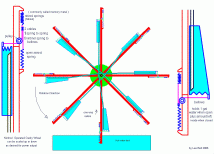|
Pack Rat Work Shop |
|
Rubber band motor with nitinol springs
I’ve been playing with rubber band heat engines a little bit over that last year. They are not very powerful and are more than a desk toy than anything but I was wondering if the design couldn’t be made to be usefull. Well, I have come to the conclusion that no they really can’t using just the rubber bands as they won’t last anytime. They work simply by heating the bands on one side which causes the rubber to shrink offseting the wheel and gravity turns the wheel. You can see many different versions of this idea on youtube. I decided to try a different approach. Instead of using rubber bands I want to use nitinol springs. They can be stretched when cool but as soon as they are heated above about 140 degrees f they return to their original shape. A lot of eye glass frames are made from this… if you accidently bend them, you just pour hot water on them and they bend back to the original shape. Handy! In this design the springs are heated by sunlight and cooled by dipping into a tank of water as the wheel spins. I have experimented with these springs before and 10 rpm is not an impossible speed to reach in this design. This engine should put out somewhere around the equivalent of 40 watts of power. The drawings show a simple design of the engine. Click either one for a larger version. |
|
Nitinol version of a Minto wheel type and teeter-totter engine This is an attempt to get away from expensive and dangerous gases. It operates somewhat the same as a regular Minto wheel but instead of using a low boiling point liquid to provide the pumping action it uses a set of nitinol springs. What happens is the NiTi springs are submerged in hot water (varies depending on spring composition) and they contract. They pull 2 cables. One goes through a pully 90 degrees and then pulls shut the lower bellows full of water. The water is pumped to the opposite bellows and gravity does it’s thing as normal The other cable just goes to another spring farther up on the arm and stretches when the other contracts. This spring is alot lighter than the operating spring and only serves to help stretch the operating spring back out when it cools out of the water. This allows the bellows to open back up a little easier when it is it’s time to be filled and helps keep the operating spring working properly. I found the springs here at http://www.robotstore.com They come 4 to a pack and at the time this is being written costs $41.95 . That would put the cost of each 10′ wheel at about $1000 to build from new materials I did some math calculations on what the output would be for a 10 wheel on one shaft version. At 10 rpm the output would be over .24 hp. Thats 178 watts or 14.8 amps at 12 volts! The output rpm can be geared up to operate a generator for battery charging. This design is actually capable of even faster rotation but that would stress the springs and reduce the their usable lifetime. If not stressed the springs will operate for millions of operations meaning many years.. Nitinol springs can be heated by electricty also but they pull a lot of current. I do not suggest the use of solar heat as they can be easily damaged if heated too hot and direct solar heat would be extremely difficult to regulate to prevent overheating. Solar energy used to heat water works alot better especially since this setup doesn’t need a very big tank at all. The second picture is a teeter-totter type setup operating two simple pumps. One pump would be used to pump water through a solar panel to heat the two tanks and the other would be used for pumping water to whatever you might want. I was thinking of using the second pump to pump water to the top of a 10′ water wheel. It wouldn’t be really fast but if the system could pump 10 times a minute, that would give me 2-3 rpm on the wheel hopefully. This setup could be multiplied side by side as one small solar panel could easily provide the heat for a number of teeter-totters . An interesting PDF list of other Nitinol Engines can be found at : http://scholar.lib.vt.edu/theses/available/etd-02102001-172947/unrestricted/ETD.pdf A Youtube movie on some government research on Nitinol engines: |


